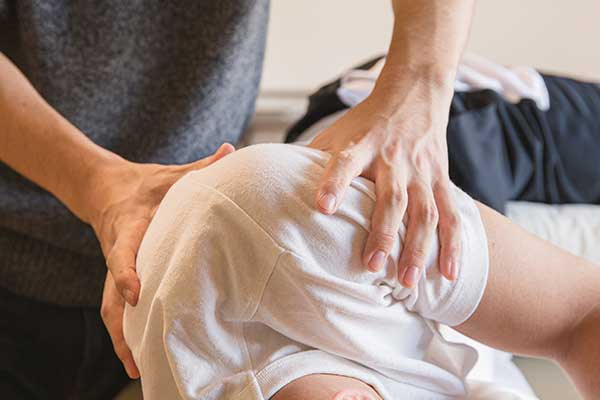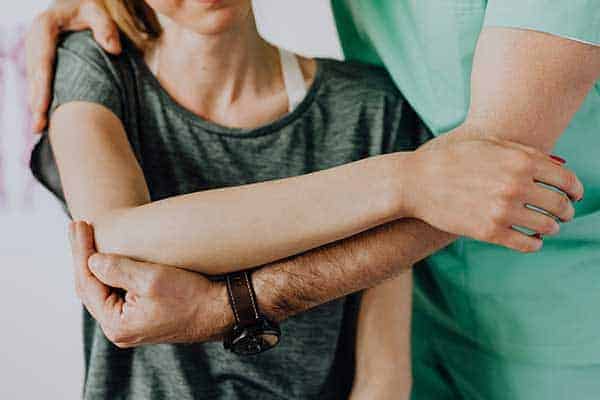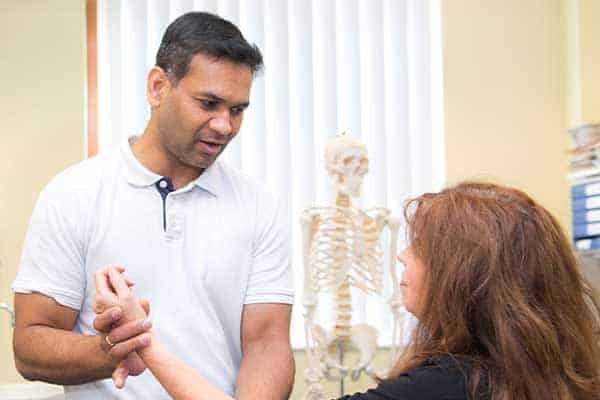Rotator cuff tears are damaged tissues in the group of muscles that surround your shoulder joint.
You can sustain a tear in a tendon that attaches one of these muscles to the bone, or in the muscle itself.
The damage can range from a minor or partial tear to a full tear where the whole tendon or muscle is affected.
What causes a rotator cuff tear?
Acute rotator cuff tears typically occur as a result of a trauma, such as a fall or lifting a weight with a sudden jerking or twisting motion. These often happen at the same time as other injuries such as a broken arm or collarbone.
Chronic rotator cuff tears, also known as degenerative tears, are a natural part of getting older and involve fibres slowly fraying or wearing out through repeated use.
What are the symptoms of a rotator cuff tear?
Depending on the type of tear, these symptoms may come on suddenly or gradually. When the tear has developed slowly over time, you may feel no pain at all.
For most people:
- You experience pain in your shoulder that may also be felt in your upper arm.
- The pain is felt when reaching above or behind you, or when lifting.
- You experience weakness that limits your ability to raise your arm.
For some people:
- You may hear a ‘cracking’ sound when moving your arm/shoulder.
- The pain gets worse with movement and better with rest.
- The pain is often worse at night, especially when you lie on your affected shoulder.
How is a rotator cuff tear diagnosed?
If you have injured your shoulder in an accident or fall, or if you are experiencing significant loss of movement in your shoulder, you should seek an assessment from a GP or another qualified health professional.
They will be able to rule out other causes of your symptoms and refer you for a scan if necessary.
What are the treatment options for a rotator cuff tear?
Treatment depends on the severity of the tear. However, in most cases, it is advisable to continue moving your shoulder with careful exercise therapy, in order to strengthen the healthy muscle and tendon fibres around the tear. This can help to relieve pain and improve shoulder function.
You could also try various treatments to manage the pain, including the use of ice and warmth, as well as over-the-counter painkillers and anti-inflammatory medications. Ask your doctor, physiotherapist or pharmacist for advice.
Surgery is not normally recommended for minor tears or chronic tears, although early repair may be considered advisable for some acute injuries. For more severe tears, or if your symptoms have not improved over time with non-surgical treatment, surgery may be advised.
Once your symptoms have started to diminish, you can gradually build up a programme of exercises to restore mobility and strength in your shoulder. Always stop if your pain increases. Physiotherapy will also be a useful option at this stage.
What is the prognosis (outlook) for a rotator cuff tear?
Recovering from a rotator cuff tear may take 3-6 months or more, depending on how severe it is and how effective your rehabilitation regime.
How can I prevent recurrence of a rotator cuff tear?
It is important not to overdo your recovery exercises or to return to sports too early.
However, it is also unwise to avoid exercise, as this can lead to further problems. Keeping healthy and active is important. Smoking has also been identified as a risk factor for soft tissue injuries, so you should ask for advice about quitting.
Pay attention to your lifting and carrying techniques. Keep heavy objects close to your body and avoid sudden jerking or twisting motions.
Recommended exercises (click to expand):
Isometric shoulder rotation
- Sit or stand against a wall with your affected arm by your side, side-on to the wall,
- Bend your elbow to 90 degrees and place the back of your wrist against the wall.
- Press your wrist against the wall as though turning your forearm outwards.
- Hold this position.
- Relax and repeat.
Band rotation
- Stand upright with your arms down, holding an exercise/resistance band (or similar) tensioned between your hands.
- Bend your elbows to a right angle to bring the band up in front of you.
- Keeping your elbows loosely at your sides and your shoulder blades back and down, rotate your affected arm outwards against the resistance of the band.
- Control the movement outwards and then back to the starting position.
- Relax and repeat.
Forward flexion with external rotation
- Stand upright with your arms down in front of you, and an exercise/resistance band (or similar) held or looped between your hands.
- Bring the band up in front of you, holding your hands apart to keep tension in the band.
- Maintaining the distance between your hands, lift your arms up towards the ceiling.
- Control this movement back down to the starting position and repeat.

How to get referred
Find out how to get referred to Practice Plus Group MSK & Diagnostics for NHS treatment.




